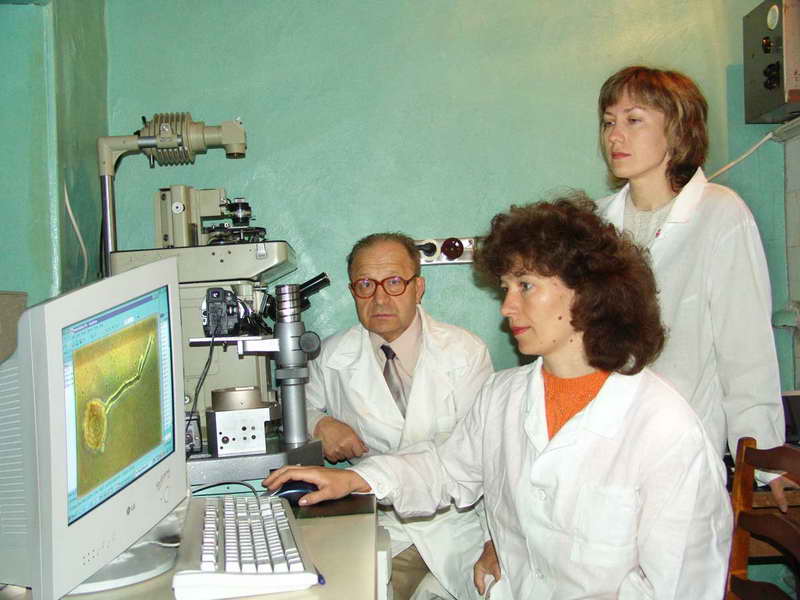The Laboratory was founded in 1950 by Corresponding Member of the USSR Academy of Sciences and the USSR Academy of Medical Sciences, Prof. N. G. Kolossov. Alongside the Laboratories of B. I. Lavrentiev and B.A. Dolgo-Saburov, it has become one of leading neuromorphological Laboratory of the country. It was the first to lay foundation for the histological basis confirming the theory of Academician I. P. Pavlov about interoreception of visceral organs. Tissue receptors of all organs were revealed and studied, the sources of their innervation were shown. New evidences were obtained for the neuronal theory, the fine structure of pericellular and pericapsular endings on autonomic neurons were described, the first comparison of pictures of classic neurohistology and electron microscopy were performed. The silver-impregnation made by the staff of the N. G. Kolossov's school up to now has been considered unique. They represent a most valuable, the « silver foundation » of neurobiology. Later, by suggestion of Academician K. M. Bykov, supravital studies of the nervous system were begun.
In 1972–1989 the Laboratory was headed by Prof. V. N. Maiorov who started the full-scale morpho-electrophysiological studies of living neurons of the autonomic nervous system with use of cinema equipment. The complete change of the Laboratory technology occurred. There appeared installations for the simultaneous microscopic and microelectrode investigations, contact optics, inverted microscopes. The neuron living structure was established to be not something fixed, but it depends on fluctuations of the external medium. For the first time, detailed supravital studies of intraorgan receptors and of changes of the finest pericellular synaptic apparatuses in situ started, criteria were revealed which allowed differentiating reversible and irreversible changes of living nervous structures. The characteristics of oxidative and respiratory metabolism of living neurons were presented.
 Since 1990 the Laboratory is headed by Prof. O. S. Sotnikov. The supravital studies of myelinated and non-myelinated nerve fibers, synapses, and receptors were continued. Summation of results of studying the « spontaneous » variability of all neuron structures has allowed formulating for the first time the concept of kinetics of all living neuron structures, this concept supplemented logically data of previous investigations of N. G. Kolossov's associates on statics of the fixed neuron and the nervous system as a whole. By using phase-contrast, anoptral, interference microscopy, and the procedure of potential fixation, it has become possible to draw a parallel between structural changes of neurons and fibers and fluctuations of their biophysical characteristics. Since 1990 the Laboratory is headed by Prof. O. S. Sotnikov. The supravital studies of myelinated and non-myelinated nerve fibers, synapses, and receptors were continued. Summation of results of studying the « spontaneous » variability of all neuron structures has allowed formulating for the first time the concept of kinetics of all living neuron structures, this concept supplemented logically data of previous investigations of N. G. Kolossov's associates on statics of the fixed neuron and the nervous system as a whole. By using phase-contrast, anoptral, interference microscopy, and the procedure of potential fixation, it has become possible to draw a parallel between structural changes of neurons and fibers and fluctuations of their biophysical characteristics.
The Laboratory was one of the first in our country to start supravital investigations of the nerve tissue culture. As a result, numerous new data were obtained and a concept of the neuron non-electrical functions was formulated. By using the neuron morphogenetic function and various growth factors the Laboratory staff for the first time grew in culture the artificial mechanoreceptor and studied it electrophysiologically. Then in tissue culture, some stages of neuroontogenesis were reproduced. By using isolated molluscan neurons in culture it was possible to reproduce all known stages of evolutionary morphogenesis of simple nervous systems of invertebrates and to formulate an addition to the main biogenetic Haeckel-Muller's law: morphogenesis of plexus-ganglion systems of neurons in tissue culture represents a fast and simplified recapitulation of evolution of simple nervous systems. Thus, a new development has been created in morphology, which allowed moving from the currently commonly accepted descriptive neuromorphology to the creative (constructive) neuromorphology. At present the Laboratory is the only one in the country, which has managed to preserve the direction of supravital morphoelectrophysiology and biological modeling of the nervous system. |